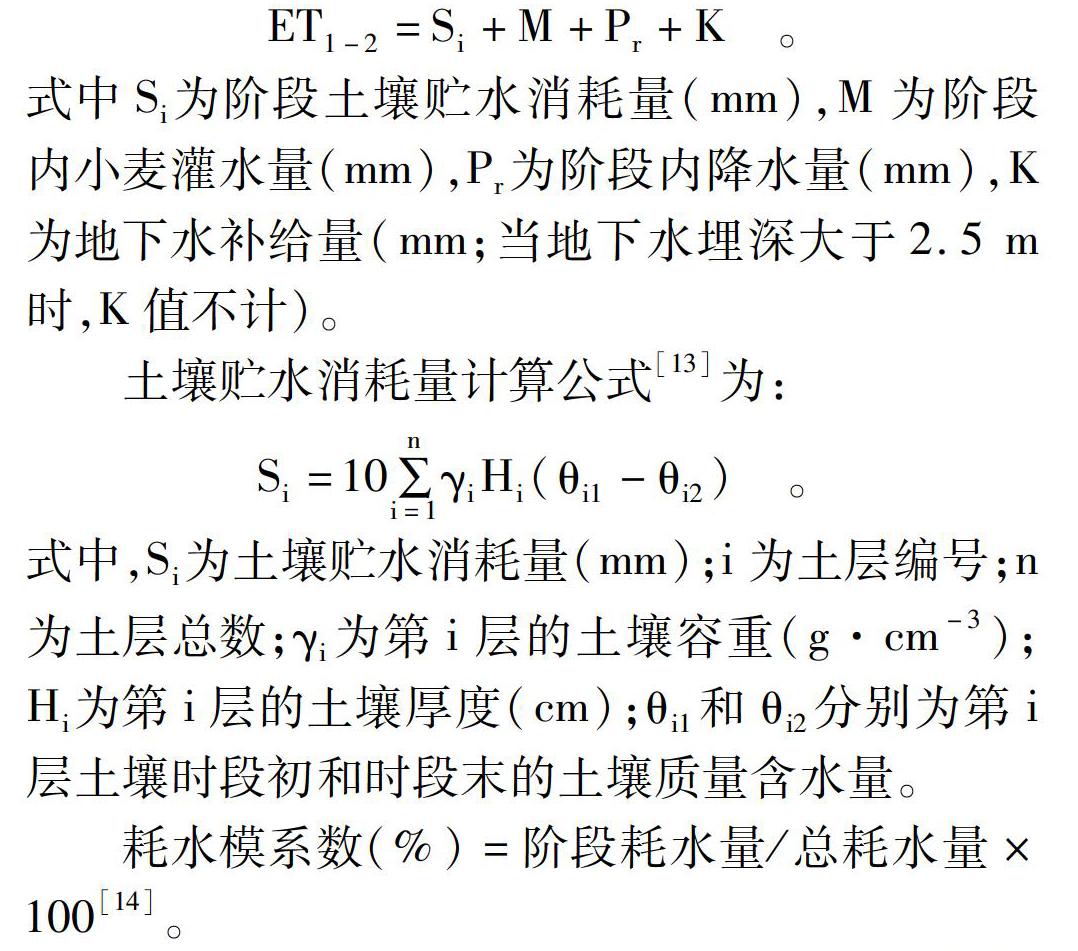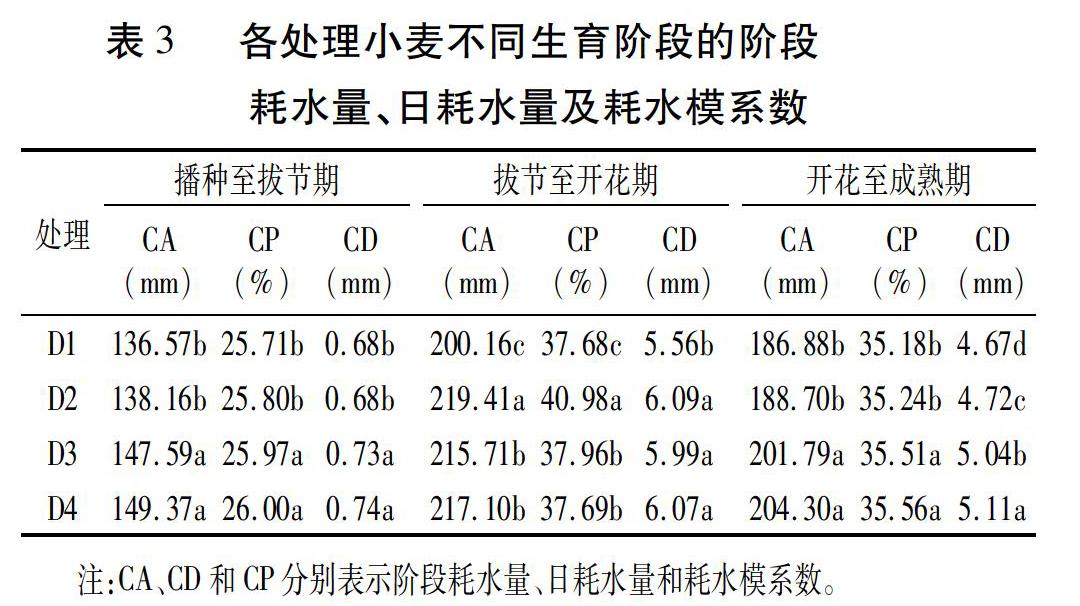宽幅播种条件下基本苗密度对小麦耗水特性和籽粒产量的影响
孔令英 赵俊晔 骆兰平 石玉 于振文



摘要:研究寬幅播种条件下不同基本苗密度处理的小麦全生育期耗水特性及籽粒产量特性,明确提高小麦水分利用效率和籽粒产量的最佳基本苗密度。于田间试验条件下,设置4个基本苗密度处理,即每公顷密度90万株(D1)、180万株(D2)、270万株(D3)、360万株(D4),测定其小麦生育期间各土层土壤贮水消耗量、小麦耗水来源及其占总耗水量的比例、各生育阶段耗水量、耗水模系数、日耗水量、籽粒产量及水分利用效率。结果表明:①土壤贮水消耗量及总耗水量均为D4>D3>D2、D1,140~160、160~180、180~200 cm土层土壤贮水消耗量D2处理显著高于D1、D3、D4。②拔节至开花期的阶段耗水量、耗水模系数D2处理均显著高于其它处理,日耗水量D2处理与D3、D4无显著差异,但显著高于D1。③土壤水利用效率、降水利用效率、水分利用效率及籽粒产量D2处理均显著高于D1、D3和D4。表明,在宽幅播种条件下,每公顷密度180万株的D2处理是降低小麦农田总耗水量、提高籽粒产量和水分利用效率的最佳基本苗密度。
关键词:宽幅播种;小麦基本苗密度;耗水特性;水分利用效率;籽粒产量
中图分类号:S512.101文献标识号:A文章编号:1001-4942(2020)04-0027-05
Abstract The characteristics of water consumption during the whole growth period and grain yield of wheat with different basic seedling densities were studied under wide sowing conditions to determine the optimum basic seedling densities for increasing water use efficiency and grain yield. Under field test conditions, four basic seedling density treatments were set as 90×104 plants·hm-2 (D1), 180×104 plants·hm-2 (D2), 270×104 plants·hm-2 (D3), 360×104 plants·hm-2 (D4), and the soil water consumption in different soil layers, sources of wheat water consumption and its proportion in total water consumption, water consumption at each growth stage, water consumption modulus, daily water consumption, grain yield and water use efficiency during wheat growth were analyzed. The results were as follows. ①The soil water consumption and total water consumption were both as D4>D3>D2 and D1, and the soil water consumption in the soil layers of 140~160 cm, 160~180 cm and 180~200 cm was higher under D2 treatment compared to D1, D3 and D4 treatments. ②The water consumption and water consumption modulus of D2 treatment at the stages from jointing to flowering were significantly higher than those of the other treatments. The daily water consumption of D2 treatment was not significantly different from that of D3 and D4 treatments, but significantly higher than that of D1 treatment. ③ The soil water use efficiency, precipitation use efficiency, water use efficiency and grain yield of D2 treatment were significantly higher than those of D1, D3 and D4 treatments. All the results showed that under wide sowing conditions, the D2 treatment of 180×104 plants·hm-2 was the best basic seedling density to reduce total water consumption of wheat farmland and increase grain yield and water use efficiency.
Keywords Wide sowing; Basic wheat seedling density; Water consumption characteristics; Water use efficiency; Grain yield
2.2 不同处理对小麦耗水来源及其占总耗水量比例的影响
由表2可知,D4处理的灌溉量最高,其后依次是D3、D2、D1处理;灌溉水占总耗水量的比例为D4、D3>D2>D1。土壤贮水消耗量为D4处理最高,D3处理次之,D2和D1处理较低且无显著差异;土壤贮水消耗量占总耗水量的比例各处理为D4、D3>D1、D2。降水量占总耗水量的比例各处理为D1、D2>D3、D4。土壤总耗水量为D4>D3>D2、D1,D2、D1处理之间无显著差异。表明,D2处理的土壤贮水消耗量低是总耗水量较低的主要原因。
2.3 不同处理对小麦不同生育阶段耗水量、日耗水量和耗水模系数的影响
由表3可知,播种至拔节期的阶段耗水量、耗水模系数、日耗水量各处理为D3、D4>D1、D2;拔节至开花期的阶段耗水量、耗水模系数各处理为D2>D3、D4>D1,日耗水量D2、D3、D4处理间无显著差异,均显著高于D1处理;开花至成熟期的阶段耗水量、耗水模系数为D3、D4处理显著高于D1、D2处理,D3与D4处理、D1与D2处理之间均无显著差异,日耗水量各处理为D4>D3>D2>D1。表明,宽幅播种条件下,D2处理拔节至开花期较高的阶段耗水量、耗水模系数及日耗水量,为形成较多单位面积穗数和增加穗粒数奠定了水分基础。
2.4 不同处理对小麦籽粒产量及水分利用效率的影响
由表4可知,籽粒产量各处理为D2>D3>D4>D1;土壤水利用效率为D2处理显著高于其它处理;降水利用效率各处理为D2>D3>D4>D1;灌溉水利用效率各处理为D1>D2>D3>D4;水分利用效率为D2处理显著高于D1、D3、D4处理,D1、D3处理无显著差异。表明,宽幅播种条件下,D2处理能够充分利用土壤水和降水,满足小麦生长发育的需水要求,获得本试验最高的籽粒产量和水分利用效率。
3 讨论与结论
前人研究表明,不同基本苗密度和不同土层的土壤贮水量可直接影响小麦全生育期的耗水量[17]。在土壤底墒充足条件下,拔节期和抽穗期0~200 cm土层土壤贮水对冬小麦耗水的贡献率分别为97.4%和94.5%;抽穗期100~200 cm土层土壤贮水对冬小麦耗水的贡献率为1.7%~8.7%[18]。秸秆覆盖条件下,112.5 kg·hm-2播量处理越冬期0~100 cm土层的土壤贮水消耗量比187.5 kg·hm-2播量处理高16 mm[19]。本试验结果表明,宽幅播种条件下,D2处理的总耗水量显著低于D3、D4处理,与D1处理无显著差异;D2处理的140~200 cm土层土壤贮水消耗量显著高于D1、D3、D4处理,有利于降低小麦总耗水量,充分利用深层土壤水分,最终达到节水的目的。
合理的基本苗密度有利于小麦生长发育,直接影响小麦各生育期耗水,从而影响籽粒产量和水分利用效率[20,21]。研究表明,在300~525 kg·hm-2[JP]范围内,增加播量可以有效提高旱地小麦籽粒产量及水分利用效率[22]。亦有研究表明,早播条件下,播量67.5 ~112.5 kg·hm-2范围内,小麦全生育期耗水量增加2~20 mm,开花前耗水量112.5 kg·hm-2播量处理的最高,开花后耗水量67.5 kg·hm-2播量的最高[6]。宽幅播种条件下,本试验D2处理拔节至开花期阶段土壤贮水消耗量、籽粒产量、土壤水利用效率、降水利用效率及水分利用效率显著高于D1、D3、D4处理,表明该处理(每公顷基本苗密度180万株)能促进小麦中后期土壤水的利用,是提高籽粒产量和水分利用效率的最佳处理。
参 考 文 献:
[1] Fang Q X,Ma L,Green T R,et al. Water resources and water use efficiency in the North China Plain:current status and agronomic management options[J]. Agricultural Water Management,2010,97(8):1102-1116.
[2] 高阳,邱新强,巩文军,等. 黄淮海平原播前土壤水分对冬小麦产量的影响[J]. 灌溉排水学报,2012,31(3):17-20.
[3] 王磊,董树亭,刘鹏,等. 水氮互作对冬小麦光合生理特性和产量的影响[J]. 水土保持学报,2018,32(3):301-308.
[4] 殷复伟,王文鑫,谷淑波,等. 株行距配置对宽幅播种小麦产量形成的影响[J]. 麦类作物学報,2018,38(6):710-717.
[5] 刘馨惠,卞城月,马长健,等. 玉米秸秆覆盖下宽幅精播冬小麦产量损失补偿效应及水分利用效率[J]. 排灌机械工程学报,2015,33(9):811-817.
[6] 田欣,孙敏,高志强,等. 播期播量对旱地小麦土壤水分消耗和植株氮素运转的影响[J]. 应用生态学报,2019,30(10):3443-3451.
[7] Ma S C,Wang T C,Guan X K,et al. Effect of sowing time and seeding rate on yield components and water use efficiency of winter wheat by regulating the growth redundancy and physiological traits of root and shoot[J]. Field Crops Research,2018,221:166-174.
[8] Ren A X,Sun M,Wang P R,et al. Optimization of sowing date and seeding rate for high winter wheat yield based on pre-winter plant development and soil water usage in the Loess Plateau,China[J]. Journal of Integrative Agriculture,2019,18(1):33-42.
[9] 韩占江,于振文,王东,等. 测墒补灌对冬小麦干物质积累与分配及水分利用效率的影响[J]. 作物学报,2010,36(3):457-465.
[10]Patanè C,Cosentino S L. Yield,water use and radiation use efficiencies of kenaf (Hibiscus cannabinus L.) under reduced water and nitrogen soil availability in a semi-arid Mediterranean area [J]. European Journal of Agronomy,2013,46:53-62.
[11]Lloveras J,Manent J,Viudas J,et al. Seeding rate influence on yield and yield components of irrigated winter wheat in a Mediterranean climate [J]. Agronomy Journal,2004,96(5):1258-1265.
[12]Dong Z Y,Zhang X D,Li J,et al. Photosynthetic characteristics and grain yield of winter wheat(Triticum aestivum L.) in response to fertilizer, precipitation,and soil water storage before sowing under the ridge and furrow system:a path analysis [J]. Agricultural and Forest Meteorology,2019,272/273:12-19.
[13]刘增进,李宝萍,李远华,等. 冬小麦水分利用效率与最优灌溉制度的研究[J]. 农业工程学报,2004,20(4):58-63.
[14]史辛凯,石玉,赵俊晔,等. 施氮量对超高产小麦品种烟农1212耗水特性和籽粒产量的影响[J]. 山东农业科学,2018,50(5):72-75.
[15]Sadras V O,Lawson C. Nitrogen and water-use efficiency of Australian wheat varieties released between 1958 and 2007[J]. European Journal of Agronomy, 2013,46:34-41.
[16]Sepaskhah A R,Tafteh A. Yield and nitrogen leaching in rapeseed field under different nitrogen rates and water saving irrigation[J]. Agricultural Water Management,2012,112:55-62.
[17]朱文美,費立伟,代兴龙,等. 雨养和灌水条件下种植密度对冬小麦产量、氮素利用率和水分利用效率的影响[J]. 山东农业科学,2018,50(8):35-41.
[18]程立平,刘文兆. 黄土塬区不同土层土壤水分对旱作冬小麦耗水的贡献[J]. 应用生态学报,2017,28(7):2285-2291.
[19]刘俊梅,曲超,杨学云,等. 播种密度对秸秆覆盖旱地冬小麦产量和土壤水分的影响[J]. 西北农业学报,2014,23(9):36-43.
[20]刘芳亮,任益锋,王卫东,等. 播期和密度对冬小麦普冰151籽粒灌浆特性及产量的影响[J]. 山东农业科学,2017,49(6):41-47.
[21]董秀春,韩伟,杨洪宾. 播量对冬小麦干物质积累、小穗结实性和产量的影响[J]. 山东农业科学,2018,50(9):31-35.
[22]张明明,董宝娣,乔匀周,等. 播期、播量对旱作小麦‘小偃60生长发育、产量及水分利用的影响[J]. 中国生态农业学报,2016,24(8):1095-1102.

